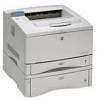HP 5100tn Printer Job Language - Technical Reference Manual - Page 94
DEFAULT, Command
 |
View all HP 5100tn manuals
Add to My Manuals
Save this manual to your list of manuals |
Page 94 highlights
DEFAULT Command The DEFAULT command sets the User Default Environment value for the specified environment variable. This value is stored in non-volatile RAM (if the printer has NVRAM) and is activated following a PJL reset condition. The DEFAULT command does not affect the current print environment, but takes effect when a PJL reset condition occurs. Use this command to change the default value for any environment setting. For printers that support the PASSWORD variable, the DEFAULT command will not take effect unless used within a secure job (a job with the correct password in the JOB command). Note In situations where the printer is shared by several users, such as networks, restrict the use of the DEFAULT command using PJL security mechanisms. This recommendation allows a standard print environment to be used and avoids having default features changed by different print jobs. Instead, if a printer feature must be changed from the default for a particular print job, use the SET command. In this way, jobs can be successfully printed in any order, since they are not affected by settings from previous jobs. When the DEFAULT command is used to change the PAGE-PROTECT, RESOLUTION, RESOURCESAVE, RESOURCESAVESIZE, IOBUFFER, or IOSIZEstatus, the printer memory is reconfigured. Reconfiguring printer memory erases all downloaded fonts, PCL macros, and PostScript dictionaries, however no I/O data is lost. Refer to "Commands that Affect Printer Memory" in Appendix A. 6-32 Environment Commands















